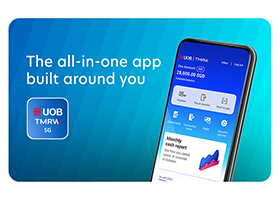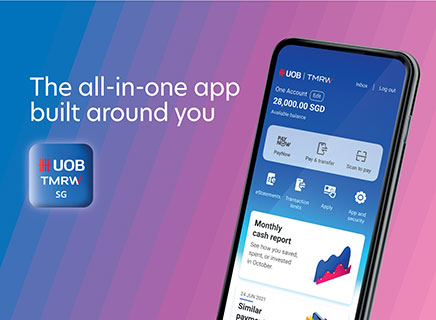Payments and transactions
Cheques
- Via Personal Internet Banking. (S$10 per cheque/cheque range)
- Call Contact Centre at 1800 222 2121 or +65 6222 2121 ( (if you are calling from overseas) (S$30 per cheque/cheque range)
- Visit any UOB Singapore branch (S$30 per cheque/ cheque range)
The clearing of cheque will be from Monday to Friday (excluding Public Holiday).
Cheques deposited from Monday to Friday (excluding Public Holidays) before the daily cut-off times will be processed on the same day*. The funds will be available on the next clearing day after 2pm subjected to the clearance of the Cheque.
*It does not apply to USD cheque deposited at UOB Auto lobby. Cheque deposited will be processed on next USD clearing day and funds will be available on subsequent USD clearing day subjected to the clearance of the Cheque.
| Cheque Currency | Cut off time at UOB Branches | Cut off time at UOB Auto Lobby |
| SGD | 3.30pm | 2pm |
| USD | 1pm | 2pm |
Yes, you can continue to present local USD cheques for deposit into your SGD accounts. The presenting bank will quote the exchange rate and clear the cheque(s) via the USD clearing mode.
An IRD is a legally accepted document that is a substitute of a dishonoured cheque. The IRD serves as a notice of dishonour and replaces the original physical cheque for the purpose of re-presentment for clearing under CTS.
Please view this image to find out more about the features to look out for in an IRD.
The IRD contains the front and back images of the original physical cheque and is printed on paper bearing the CTS watermark. Every IRD also bears a serial number for strict control purposes.
- The IRD conveniently contains, in one document, the following information:
- the reason for its return
- whether it can or cannot be presented
- the validity period for its presentment
- the number of times the cheque has been re-presented - The IRD is also more secure as alteration is not allowed, thereby eliminating the possibility of unauthorised alterations.
You can present the IRD over the counter or drop it into the Cheque Deposit Box at any branch of the same bank that you originally deposited the cheque. Please ensure that your Name, Account Number and Contact Number are written behind the IRD.
You can present the IRD over the counter or drop it into the Cheque Deposit Box at any branch of the same bank that you originally deposited the cheque. Please ensure that your Name, Account Number and Contact Number are written behind the IRD.
You should return the IRD to the drawer in exchange for a new replacement cheque. The replacement cheque should address the reasons for the return of the IRD in order that it can be cleared successfully through CTS.
Yes. An IRD can be presented so long as it is valid for presentment, not altered or mutilated.
Alterations are not allowed on the IRD as an altered IRD will not correspond to the stored cheque image in CTS. We advise you to request another cheque from the drawer under such a circumstance.
No. As an IRD is a substitute of a dishonoured cheque, the torn IRD will be regarded as a torn cheque. We advise you to request another cheque from the drawer under such a circumstance.
As an IRD is a substitute of a dishonoured cheque, the lost IRD will be regarded as a lost cheque. We advise you to request another cheque from the drawer under such a circumstance.
We also advise the drawer to place a 'Stop Cheque' instruction on the lost IRD.
An IRD can only be presented for clearing and not for encashment. However, if the original cheque is valid for encashment, you may request to exchange the IRD for the physical cheque at the bank's discretion. In such cases, you would have to surrender the IRD and pay a service charge of S$50 for each physical cheque requested.
Please be assured that under the Bills of Exchange Act, the IRD is recognised as a legally accepted document that replaces the physical cheque for re-presentment. In addition, every IRD bears such security features as the CTS watermark and a serial number for strict control purposes.
No, there will not be any charges as the IRD is a replacement of the physical returned cheque.
All cheques cleared via CTS will be issued an IRD if they are returned.
No. A new IRD will be generated for each return of the same cheque. Therefore, if an IRD is presented and subsequently returned, another IRD will be generated stating clearly that it is the second IRD.
GIRO
If you have access to UOB TMRW or UOB Personal Internet Banking, you can login to your account and terminate the GIRO arrangement online.
UOB TMRW
- Please tap on 'Services' icon in the bottom bar and select 'Manage GIRO'.
- Tap on your existing GIRO arrangement and swipe right to cancel.
UOB Personal Internet Banking
- Please click on Pay and Transfer > Upcoming Payments > GIRO > Action > Edit > Termination Date > Input termination date > Save.
- Alternatively, you may wish to obtain the termination form from your billing organisation.
eGIRO
eGIRO stands for Electronic GIRO. It is a digital initiative that digitises the GIRO application (Direct Debit Authorisation) process with an aim to reduce the GIRO set-up turnaround time significantly. This is a joint initiative by The Association of Banks in Singapore (ABS), Monetary Authority of Singapore (MAS) and participating banks.
Please refer to ABS website for the latest list of participating banks.
You can now apply for GIRO via the billing organisation’s website to get eGIRO set up in minutes. All you need to do is specify your designated bank for the payment through GIRO.
At the bank’s internet banking login page, log in and select the bank account that the payment will be deducted from.
Applicant will receive a confirmation with the eGIRO application is successful.
No. Currently, GIRO applicant (payer) can only create an eGIRO via a participating billing organisation’s application or website.
You will need to open a savings or current account with one of the participating banks to be a Billing Organisation or an Applicant on eGIRO.
The turnaround time for eGIRO application is reduced to only 10 minutes.
- Reduction in turn-around time from average 3-4 weeks to 10 minutes
- Seamless, hassle-free and secure online setup
- Environmentally friendly by going paperless
There are currently 25 participating billing organisations, including AIA Singapore, FWD Insurance Singapore, Shopee and Starhub. Please refer to ABS website for the latest list of participating billing organisations.
ABS and participating banks are working with the industry to onboard more banks and billing organisations onto eGIRO.
eGIRO is available 24*7.
Inward Remittance
Please refer to our table of charges on Inward Remittance Fees
Please provide your remitter or remitting bank the following information:
For SGD Payments
- Pay to "UOB Singapore (SWIFT BIC: UOVBSGSG)"
- Favouring Beneficiary:
- Full Beneficiary name as per Bank records
- Account numbers for UOB Current or Savings Account
For foreign currency remittances to accounts with UOB Singapore:,
- Pay through UOB Singapore Nostro Agents for respective currencies. For the list of nostro agents, please refer to List of UOB Agent Banks.
- Beneficiary Bank: United Overseas Bank Limited Singapore (SWIFT BIC: UOVBSGSG)
- Favouring Beneficiary:
- Account numbers for UOB Current or Savings Account
- Full Beneficiary name as per Bank records
SWIFT Code: UOVBSGSG
Yes, you will need to inform the remitter or remitting bank to route the payment through The Bank of New York immediately. Otherwise, these payments may be rejected by Citibank / HSBC by Q2 2017. Please refer to question (2) for the payment instructions to be provided.
After the TT is successfully processed, you will be able to receive the hard copy credit advice within 2 – 3 working days. For clients with Business Internet Banking Plus (BIBPlus) access, the electronic credit advice can be retrieved after the TT is successfully processed.
This is a fee charged by our USD agent bank for processing the transaction.
This fee is not new. It is a market practice for intermediary banks to deduct their processing fee from the remittance amount when the remitters indicate charge code SHA or BEN in their payment instructions. Some agent banks have not been charging this fee in the past but they have started with effect from Jan 2017.
We are unable to waive the fee which is charged by our USD agent bank.
This fee is not deducted by UOB and hence will not be reflected in the credit advice from UOB.
Please refer to our List of Nostro agents.
You may provide the remitting bank with the following information:
- Pay to "UOB Singapore (SWIFT: UOVBSGSG)"
- For Account of/ favoring: Beneficiary's name and account number (10 digits)(Names and account numbers must be as per Bank records)
- Beneficiary bank name and address:United Overseas Bank Limited80 Raffles PlaceSingapore 048624
Kindly note that there will be a SGD $10 or equivalent for each inward remittance into UOB SGD or Global Currency accounts. The exchange rate used will be quoted by our bank's buying prevailing TT rate to convert into SGD before crediting into the designated UOB SGD account.
If information on Bank and Branch code is required, we have also attached the following link "ACH Bank and Branch Code" for your easy reference: http://www.uob.com.sg/assets/pdfs/global/achcode.pdf. Please use the first 3 digits of your UOB account number and refer to Appendix A to retrieve the corresponding bank and branch code. For example: For account 101-123-456-7, please use 101 to refer to Appendix A to retrieve the Bank Code 7375 and Branch code 001
Outward Remittance
TT is a term used for electronic transfer of foreign currency funds from one party (remitter) to another (beneficiary).
Fees are often charged by the Remitting bank, the Correspondent banks, and/or in some cases by the Beneficiary bank.
The type of TT charges which are applicable include:
- Telex: Remitting Bank's cable charges
- Commission: Remitting Bank’s handling charges
- Agent Charge: Charges imposed by UOB Correspondent Bank. This is only applicable if you have indicated charge option 'OUR' in the TT instruction.
When payments are made locally and overseas, charges are imposed by various banks e.g. the Remitting bank, the Beneficiary bank, the Intermediary bank, etc. These charges can be paid or settled in one of the following ways:
a) BEN: Charges are borne by the Beneficiary
Your Beneficiary bears all charges of the banks engaged in the transfer of the payment. You only pay the remittance amount. All charges (Remitting bank's as well those of the Intermediary and Beneficiary banks, etc.) will be deducted from the remittance amount and your Beneficiary will receive the remaining balance.
b) SHA: Charges are shared
You pay for the Remitting bank's charges and the remittance amount. Your Beneficiary bears the charges of all the other banks' (the Intermediary and Beneficiary banks, etc.), which will be deducted from the remittance amount. Your Beneficiary will receive the remaining balance. This is the most common type of charge, where each party bears their respective charges.
c) OUR: Charges are borne by the Remitter
You bear all charges of the payment, i.e. the remittance amount, Remitting bank's charges, as well as all the other banks' (Correspondent, Intermediary and Beneficiary banks etc.). The charges will be debited from your indicated account after the exact amount has been identified. For cases where we have "OUR" arrangement with our correspondents, we will debit the agent charges upfront.
UOB shall not be liable if our correspondent or the Beneficiary's bank does not follow the instructions and lifts their fees from the remittance amount or if full payment fails to reach the Beneficiary's account for any other reason.
This form of payment is the most expensive for you; where possible, you should opt for SHA (shared charges) or BEN (charges borne by the Beneficiary).
Please refer to our table of charges on Outward Remittance Fees.
Yes. The applicable bank charges i.e. Commission, Telex and Agent Charge will be reflected accordingly on the debit advice.
The Bank has noticed an increase in the number of Indian Rupees (INR) and Philippine Peso (PHP) outgoing Telegraphic Transfer (TT) payments being returned by our agent bank. This is due to the transaction amount of these TT being less than the agent/correspondent bank fees.
Hence, with effect from 1 November 2017, all outgoing TT transacted in INR and PHP will be subject to a minimum amount of S$200 or equivalent. Transactions below the stipulated amount will not be effected.
If the TT instruction is submitted at our branches, the TT application form for effecting the payment will not be accepted.
If the TT instruction is submitted via our electronic channels, you will subsequently get a reject status with reason “Payment is below min txn amt of S$200.” for this payment electronically.
You can consider combining a few payments to the same beneficiary so that the payment amount is at least S$200. In addition, you can also save on the bank TT fees.
To ensure that your application is processed promptly, please provide the following information accurately:
- Your name, address and account number
- The payment currency code and amount
- The Receiving Bank/Beneficiary bank's name and address
- Beneficiary bank's routing code
- Name of Intermediary bank, if available
- Beneficiary's account number or IBAN for payments to European countries or United Kingdom
- Full Beneficiary name
Notes for cross-border remittances going to or through Mainland China:
According to People’s Bank of China (“PBOC”) Document (2018) No. 130, PBOC is imposing regulatory requirements on customer identification for cross-border transfer business.
With effect from 14 December 2018, the following customer identification requirements will apply for cross-border remittance transactions to or through Mainland China. Payment instructions with missing information will be rejected by the Clearing Bank. For more information, click here.
There are some countries with payment restrictions, hence additional payment details need to be provided for payments that are being made to beneficiaries in their countries or in their country currencies. Omission / insufficient information will result in the TT payments getting delayed or rejected. For more information on the additional payment details required for the beneficiary country or remittance currency, please refer to our table on Additional Payment Details.
TT payments may still be rejected if the purposes of payments are not clear and not specific. Some examples of detailed reason of payment to be provided include:
- Payment for purchase / rental of car/property
- Investment Income
- Payment for legal services
- Housing loan repayment for ABC apartment
- Donations for 123 charity
- Inter-company transfer to own current account in Malaysia
Please note that, with immediate effect, in accordance with Bank Negara Malaysia's rules, it is mandatory to provide a detailed reason for Telegraphic Transfer payments made to beneficiaries in Malaysia. Payments without or with an unclear reason may be delayed / rejected. Other documents may be requested to support the payment request.
Payment can be effected in full when you mark "ALL CHARGES INCLUDING THOSE OF OTHER BANKS TO BE PAID BY ME/US". For USD payments, please mark as "/FULLPAY/". In both scenarios, the charge code OUR should be indicated. Please refer above to Question 3(c) above for further details.
The payment will generally reach the Beneficiary within 1 to 5 business days. However, this would vary according to the country and beneficiary bank to which payment is made.
The same would apply if you have performed the TT transaction online.
You may refer to our Outward Telegraphic Transfer cut-off timings to determine the value dates which will be applied based on currency and submission timings.
You can download the application form located under the Trade Services / Remittances section.
Alternatively, you can obtain the application form from any of our UOB branches in Singapore.
Only the account Authorised Signatory(s) is / are allowed to sign on the TT application form, subjected to account signing conditions, if any.
This is the same for amendment form. However it is not necessary for the original signers who have signed off on the TT application, to sign on the amendment form, as long as they are the one of the authorised signatories (subjected to the account signing conditions).
All forms must be signed according to your account signing conditions.
After the TT is successfully processed, you will be able to receive the hard copy debit advice within 2 – 3 working days. For clients with Business Internet Banking Plus (BIBPlus) access, the electronic debit advice can be retrieved after the TT is successfully processed.
UniAlerts
"UniAlerts" is a value-added service that alerts you on your account activities. You can choose to receive alerts via email, push notification or SMS.
No, this service is provided free of charge.
The UniAlerts service is available to all UOB customers with a UOB personal Savings/Current account and/or Principal Credit Card.
As a UOB Supplementary or/and Debit Cardmember, you will not be able to register for any of the credit card alert services. However, if you hold a UOB Personal Savings or Current Account, you can register for any of the banking alert services.
Simply log in to UOB TMRW app > Services > Notification settings or UOB Personal Internet Banking and click on Account Services > Manage Notifications to select your preferences.
Depending on your alerts setting, you will receive notification via Push Notification to your UOB TMRW app and email alerts for your relevant transaction, to the latest mobile number and email address registered with UOB.
Note that from April 2025, the existing SMS alerts will be progressively changed to push notifications via UOB TMRW and email alerts for impacted digital, banking and card transactions. Click here for details.
To update your alerts setting for your transactions, please log in to UOB TMRW app > Services > Notification settings or UOB Personal Internet Banking > Account Services > Manage Notifications.
Below is the list of transaction alerts that UOB is currently offering and the transaction alert default setting, which you will also have the option to subscribe to selected alerts. It is important to subscribe to transaction alerts to be alerted of any potential fraudulent activity.
Simply log in to UOB TMRW app > Services > Notification settings or UOB Personal Internet Banking > Account Services > Manage Notifications to subscribe or to select your preferred alert mode or trigger amount.
*Note that from April 2025, the existing SMS alerts will be progressively changed to push notifications via UOB TMRW and email alerts for impacted digital, banking and card transactions. Click here for details.
| Category | Impacted Transactions | Default notification mode | Default Threshold (S$) |
| Online transfers and payments | Digital transactions including all types of fund transfer, telegraphic transfer, QR payment (local and overseas), bill payments, online cash advance, eNETs payments | Push notification and email | 100 |
| Adding of payee, biller or beneficiary | No threshold | ||
| GIRO setup approval | SMS and Email | No threshold | |
| GIRO payments and standing orders (including Electronic Direct Debit Authorisation) | Unsubscribe | 1,000 | |
| No threshold | |||
| Upcoming GIRO payments and standing orders reminders (including Electronic Direct Debit Authorisation) | |||
| Card activity* | Card charges (includes payments and cash advances) | SMS and email | 500 |
| SmartPay, LuxePay, Instalment Payment Plan and UOB Personal Loan monthly instalments | 1,000 | ||
| NETS chip payments | 1,000 | ||
| NETS contactless and online payments | 1,000 | ||
| NETS transaction made on the CDA account | 0.1 | ||
| Low credit limit reminder | Unsubscribe | No threshold | |
| Upcoming card bill payment reminders | |||
| Confirmation of card bill payments received | |||
| Investments, fixed deposits and insurance | Instructions for securities, bonds, unit trusts and insurance products (includes Electronic Payment for Shares (EPS) and Share payments via ATMs) | Push notification and email | No threshold |
| Fixed or structured deposits placements | |||
| CPF or SRS accounts top-ups. | |||
| Buy/sell gold and silver | 1 | ||
| Securities and bonds allocation and redemption updates | Unsubscribe | No threshold | |
| eStatement | eStatement is ready for viewing | Push notification and email | No threshold |
| Security and money lock | Transfer and payment limit updates | Push notification and email | No threshold |
| Money lock limits update | |||
| When available balance is lower than money lock limit, and when transactions fail due to money lock | |||
| Mailing address update | |||
| ATM | Cash withdrawal in Singapore and Overseas | SMS and email | 500 |
| ATM transactions - funds transfer, bill payment | 1,000 | ||
| Top-ups to CashCards or NETS FlashPay cards/ Apply rights application/Apply SGS/Apply SSB/Apply T-bills | No threshold | ||
| Cheques, cashier's orders and demand drafts | Demand drafts and cashier’s orders | Push notification and email | 1,000 |
| Adding of beneficiary for cashier’s orders and demand drafts. | No threshold | ||
| When cheques are cashed in | SMS and email | 1,000 | |
| Others | Certain payments, refunds, and payment reversals made outside of UOB TMRW and Personal Internet Banking | Unsubscribe | 1,000 |
* For Card activity alerts, customers’ preferred alert mode of “SMS” or “Email” will be upgraded to “SMS and Email”, Customers’ preferred alert threshold, where applicable, will be retained.
Below is the list of transaction alerts which customers are unable to change their notification mode.
| Impacted Transactions | New notification mode (after 19 April 2025) |
| FX+ currency conversion (via UOB TMRW) | Push notification and email |
| Contact details update (via UOB PIB and UOB TMRW) | Push notification and SMS |
| Unsubscribe from GIRO and Standing Order alert, and certain payments alert via PIB/TMRW | Push notification and email |
| Change eStatement subscription | Push notification and SMS |
| 1st card transaction | Push notification, SMS and email |
| Block/Unblock card (via UOB TMRW) | Push notification and email |
| Kill Switch (disable digital access and block cards) | SMS and email |
When we dispatch an alert, we cannot guarantee that you will receive the alert on the same day. Once an alert is dispatched from our system, it is transmitted to you through the relevant communications network, for example, through your email or mobile service provider.
Failure of the mobile network or email server at any point during the transmission can cause a delay or failure in receipt on your end.
Change your contact details on UOB TMRW app
Update on UOB TMRW app instantly so you don't miss any important notifications and alerts. Simply follow these steps:
Step 1: Log in to UOB TMRW and tap on "Services" located at the bottom of the screen.
Step 2: Under Profile, select "Contact Details".
Learn more
Alternatively, you could also change your contact details on UOB Personal Internet Banking or visit any of our branches island-wide.
For SMS-OTP user, the mobile phone number registered for SMS-OTP will be used for UniAlerts if you subscribe to the service. You will not be able to update your mobile phone number for UniAlerts only.
No, if you have registered your mobile number with the bank, both SMS-OTP and UniAlerts will be using the same bank registered mobile number.
Notification alerts allow you to be updated on your account activities and act swiftly in the event of fraud, and these alerts will be sent to you either by email, push notification or SMS*. It is important to subscribe to transaction alerts to be alerted of any potential fraudulent activity.
If you wish to unsubscribe from transaction alerts, you may log in to UOB TMRW app > Services > Notification settings or UOB Personal Internet Banking > Account Services > Manage Notifications from the left navigation menu.
*Note that from April 2025, the existing SMS alerts will be progressively changed to push notifications via UOB TMRW and email alerts for impacted digital, banking and card transactions. Click here for details.
The use of the service is governed by the Terms and Conditions Governing Digital Services















